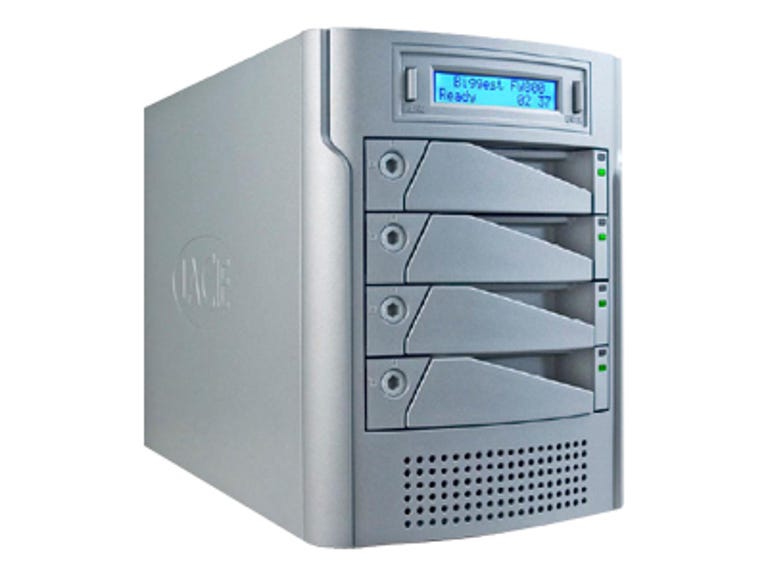 Why You Can Trust CNET
Why You Can Trust CNET LaCie Biggest FW800 review: LaCie Biggest FW800
LaCie Biggest FW800
The LaCie Biggest FW800 is a four-bay external SATA RAID drive that supports several levels of RAID, hot-swapping, and a variety of connection options. It comes in two capacities: 1 terabyte ($1,050) and 2 terabytes ($1,530). Connection options include USB 2.0, FireWire 800, and FireWire 400 (using a FW400-to-FW800 cable). The included documentation walks you through the simple setup procedure, which does not require you to install drivers. A two-line text LCD sits on the front of the drive and relays information such as the drive's status and RAID level. Two LEDs on each drive bay blink or glow different colors, depending on the drive's status. The Biggest FW800 supports HFS+, FAT32, UNIX, and NTFS file systems, which makes it appropriate for various combinations of operating systems. The only major feature the FW800 lacks is a backup utility, which is odd, considering LaCie does have a proprietary utility in the form of the LaCie 1-Click Backup for Windows PCs and SilverKeeper for Macs.
The Good
The Bad
The Bottom Line
Most multidisk hard drives of this size and price are network-attached storage drives, making the non-networked Biggest FW800 an expensive option by comparison. For example, the Buffalo Terastation Home Server offers 1 terabyte storage, a media server and print server, and external USB ports, plus a gigabit Ethernet connection--for $900. Our inclination is to spend the money on a NAS drive that offers more features, but LaCie is targeting the professional audio/video producer market that needs local backup and fast throughput for quickly moving large AV files. (Fast Ethernet has a maximum throughput of 100Mbps, while USB 2.0's theoretical max throughput is 480Mbps and FireWire 400's max is 400Mbps.)
| Drive type | External RAID array |
| Capacities | 1TB, 2TB |
| Capacity of test unit | 1TB |
| Number of drives/bays | Four drives, installed |
| Maximum capacity | 2TB |
| Hot/cold swap? | Hot-swappable drives |
| Dimensions (HWD) | 8.13x6.0x10.57 inches |
| Notable design features | 2-line text LCD; front-loading hot-swappable drive bays; 2 LEDs on each drive bay that indicate drive status |
| Connection options | USB 2.0; FireWire 800 (2 ports); FireWire 400 (using FW400-to-FW800 adapter; serial/RS-232 port |
| Operating systems supported | Windows: 2000, Server 2003, XP, and Vista; Mac OS 10.2.8 or later |
| Software included | none |
| RAID implementations | RAID 0; RAID 0+1; RAID 5; and RAID 5+hot spare |
| Additional features | Driverless installation |
| Service/support | Two-year standard warranty; phone support available weekdays from 6 a.m. to 6 p.m. PT (toll call); Web site includes FAQs, online support form, and downloadable software and documentation |
Almost all the RAID-capable drives we've tested and reviewed are NAS drives, so we can't make direct comparisons with the LaCie FW800. We tested the drive in its default RAID 5 mode (quick explanation here Using the USB 2.0 connection, the drive wrote our 10GB test folder in 25 minutes, 11 seconds, or 6.78Mbps. It read back the same folder in 9 minutes, 48 seconds, or 17.42Mbps. The FireWire 400 results were very similar: 25 minutes, 27 seconds to write (6.71Mbps) and 9 minutes, 8 seconds (18.71Mbps) to read. These numbers are slower than those for non-RAID hard drives, but that's to be expected. RAID 5 implementations are also slower than RAID 0 or RAID 1 arrays.
Although the FW800 is advertised as hot-swappable, LaCie recommends not replacing the hard disk drive yourself in case of failure (that is, separating the hard drive from the drawer that slides into the drive bay); doing so will void the warranty. LaCie does sell replacement preinstalled hard disks, i.e., the hard drive plus the drive drawer, that you can hot swap on your own. The 250GB version costs $200, and the 500GB version costs $350. The other alternative is to contact LaCie customer support. This setup isn't nearly as convenient as that of the Drobo, which allows you to install naked hard disks directly into the enclosure. Drobo also offers data protection using some of the same techniques RAID uses, but includes some proprietary schemes as well. We found Drobo simple to use, but it has limited connection options. So far, only a USB 2.0 connection is available, though Data Robotics is working on an Ethernet version. Also, Drobo is on the expensive side: $500 without drives.
